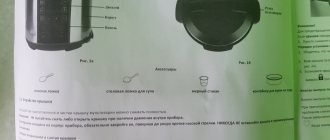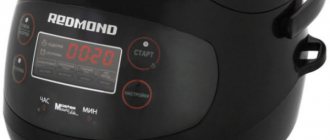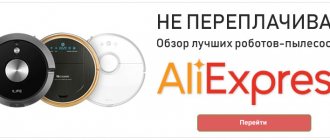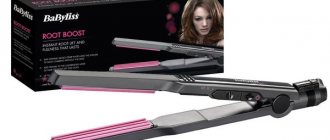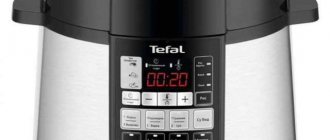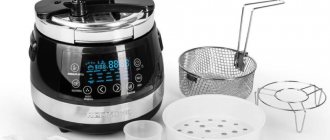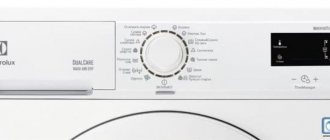Multicooker - modern multifunctional household appliance, which, without exaggeration, should be in every home today.
After all, with its help you can not only cook crumbly porridge or stew vegetables, but also fry, bake, deep-fry and steam .
Naturally, not every multicooker has such wide functionality. We'll tell you how to choose the best electrical appliance and not make a mistake.
Page navigation:
Types of multicookers
The multicooker itself is a removable bowl (saucepan), which is located in a sealed housing with a heating element, temperature sensor and auto programs. Since this device is very popular and widespread, you can find some subtypes on the market:
- The multicooker itself is a regular model with a standard set of functions, accounting for approximately 80% of all types of multicookers.
- Multicooker-pressure cooker. Thanks to its sealed design, food is cooked under pressure, which means much faster. For example, chicken meat is cooked in just 15 minutes.
- Slow cooker (specializes in simmering meat for a long time).
- A rice cooker specializes exclusively in cooking rice (mainly for sushi).
- A multi-kitchen is a multi-cooker + electric stove (sometimes also a blender). The heating element in it rises and you can place a frying pan or other metal utensils on it. Large, heavy, expensive, but also very functional.
Additional options and functionality
Decide what useful additional features you will need. We don’t recommend buying multicookers with bells and whistles that you don’t plan to use - why pay the extra money? It is better to choose a multicooker according to the parameters that suit you.
Additional multicooker options
Modern multicookers support the following:
- Delayed start . The device will start cooking food at the time you specify. For example, you can set the pressure cooker to prepare soup just before you return from work.
- Sous-vide . Possibility of cooking in a vacuum. You place frozen vegetables or vacuum-packed meats into the multicooker bowl. The device will cook them in hot water heated to 70°C. Thanks to sous vide, the product retains all the beneficial substances, microelements and vitamins, and the dish turns out very tasty and juicy.
- Maintaining food temperature . The appliance will keep food warm at the level you set. If you are late in preparation, you will still eat the dish hot.
- Control from a smartphone . The multicooker connects to the gadget via Bluetooth. By downloading the proprietary application, you can set cooking programs and change the heating temperature from another room from your phone.
Multicooker: pros and cons
Let's first find out whether it's worth buying a multicooker at all or is it worth cooking the old fashioned way? We have summarized the opinions of buyers and experts in one table:
| Arguments for" | Arguments against" |
|
|
As you can see, the score is in favor of the multicooker - it clearly has more advantages than disadvantages. All that remains is to choose the optimal model, and we will help you with this.
Moreover, a multicooker will certainly come in very handy at the dacha, for a student in a dormitory, in a construction trailer or a rented country house during a vacation in the wilderness.
Now let's move on to our practical selection tips.
First, take a look at this awesome infographic.
Program selection
When choosing a device with a lot of basic programs, keep in mind: a multicooker with fewer options can handle other dishes. For example, the “cooking” mode will help to cook soup or broth, that is, the additional functions “soup”, “broth”, “compote” will be unnecessary. The same unclaimed functions may be the “dumplings” or “pasta” mode when there is a “spaghetti” option, as well as “rice”, “oatmeal” when there is a “buckwheat” mode.
Tip 1. Set the right priorities when choosing a multicooker
What characteristics should you first pay attention to when choosing a multicooker? Here is a short list of them in descending order of importance:
- 1. The bowl is the most important component of the multicooker. It is the one that is used the most and is the one that is most often changed. There are two nuances here: material and volume. More details about choosing a bowl will be written below.
- 2. Design features (removable parts, type of heating element, condensate drainage system and much more).
- 3. Power. The more powerful the multicooker, the faster it heats the bowl. A critical parameter for multicookers.
- 4. Software part, management and configuration. For the most part, a standard set of modes and accessories awaits you, but sometimes there are surprises (both pleasant and not so pleasant).
- 5. Reviews. Be sure to read reviews about the model. Characteristics and marketing descriptions are one thing, but a real story from a person (owner) like you is another. As a rule, in the reviews you can find interesting practical pros and cons of using a specific multicooker.
- 6. Company (article on the topic: “Which company is better to buy a multicooker?”)
- 7. Design - can only be important for those who buy a multicooker not as a household appliance, but as a decorative element for the kitchen. Do you need a functional kitchen assistant or a piece of furniture?
This, so to speak, is a summary of the most important things. Now, let's take a closer look at each of these nuances, because they all affect the result of choosing a multicooker.
Advantages of a multicooker over other household appliances
Why buy a multicooker if every kitchen already has a stove and oven? This multifunctional unit does not duplicate the queen of the kitchen - the stove, but complements it, replacing several more useful but infrequently used appliances, saving you time, money and making cooking easier and more enjoyable. Here are the main reasons for bringing this kitchen helper into your home:
- Economical:
- Saves time: the device monitors the temperature and cooking time without requiring your constant presence in the kitchen.
- Saves money: a multicooker will replace not only the stove and oven, but also a steamer, bread maker, yogurt maker and a number of other units
- Saves electricity: the power of a standard multicooker is 800-900 watts, while the power of electric cookers with a built-in oven can reach 10 kilowatts. The multicooker consumes up to 10 times less electricity without compromising the quality of cooking.
Multicookers first appeared in the UK in the 1920s and were promoted as energy-efficient kitchen appliances that could save you money on your gas bills.
- Reliability and safety:
- Modern multicookers are equipped with heat sensors and independent fuses that completely control the operation of the unit.
- Unlike most cookers, the slow cooker automatically turns off once the food is cooked.
- The heat-protective housing will prevent you from getting burned if you accidentally touch the operating device.
- The non-volatile memory will restore the multicooker settings if the electricity goes out briefly during cooking.
- Convenience:
- Even if you take a break from kitchen chores for a while, the multicooker will ensure that your dish does not burn.
- Thanks to the delay start function, fresh hot food will be ready when you need it.
- Almost all modern multicookers are equipped with collections of recipes adapted to the capabilities of this particular model. Not to mention entire Internet communities of fans of this or that brand, who adapt classic world culinary recipes for their home multi-cook.
Tip 3: Choose not by the type of coating, but by the thickness of the bowl
Many buyers of multicookers mistakenly believe that it is more important to decide on the type of coating of the bowl than to find out how thick it is.
Imagine this example. You have two bowls in your hands. The first is light, as if made of thin tin, scary to drop, but with a ceramic coating. And the second one is thick, heavy, and the coating is indicated as simply non-stick. Which bowl will you choose?
The right choice is the second bowl! A thick-walled bowl will last you many times longer. It won't be a problem for food to get mixed up in it, it won't be scary to hit it on the sink, it will withstand a fall and frequent use.
Therefore, we advise you to pay attention to the thickness of the bowl. It should be from 1.5 to 3.5 mm. The bowls in Moulinex and Tefal multicookers have proven to be the best in this regard.
If we talk about the covering of the bowl, then it comes in three types:
- Teflon is a regular non-stick coating. It is considered the least environmentally friendly (throw away at the slightest damage).
- Ceramic is a more modern and safer coating, but requires careful use.
- Branded non-stick is a multi-layer internal coating, the composition of which differs for each manufacturer. Practice has shown that the thicker the bowl, the more non-stick layers there are, which is very good.
They may also differ in shape, but it seems to us that this has little effect on the result.
Bowl and body
The next couple of characteristics concern the material and design of the multicooker itself. As a rule, the multicooker body is made of plastic, metal, or a combination of both. Plastic is lighter, metal is more durable in case the house is terrorized by a child or a cat.
Another thing is the bowl, that is, the very pan in which you will cook. Decide on its volume: the multicooker bowl can be from 2 to 9 liters. The larger the bowl, the larger the dimensions and weight of the device.
A separate question is what material the bowl should be made of: metal or ceramic . A nutritionist's advice will help here: if you want to cook without oil, definitely choose ceramics. In addition, the ceramic bowl is easy to clean, since almost nothing sticks to it.
A metal bowl with a non-stick Teflon coating (provided that it is of proper quality) is also easy to clean, but the price of such multicookers is much lower. This simple Vitesse makes it into the customer rating precisely because of its ease of cleaning:
Tip 3: Choose the right bowl size
The choice of multicooker capacity is influenced by how large your family is:
- 2-3 liters is enough for a bachelor or student;
- For a family of 2-3 people, the optimal volume would be 5 liters;
- For large families - 6 liters.
If you buy a bowl that is too small, you will have to cook every day, or even a couple of times a day. Otherwise, a multicooker that is too large will cost more, take up more space and work at half capacity (with the same electricity consumption).
Important! In some models there may be so-called nominal and actual volume. For example, the multicooker says 6 liters, but when you take out the bowl you can see that the maximum allowable mark in the bowl is 5 liters. Keep this in mind, especially if you are going to cook soups, borscht and the like in it.
Most popular models
Currently, multicookers are found in the assortment of many household appliance manufacturers. But how to choose a multicooker that is optimal in price and quality? The brands in greatest demand are Redmond, Brand, Polaris, Philips, Panasonic, Moulinex, Daewoo and Supra. If prices are of paramount importance when choosing, then the cheapest model is from Daewoo (50 USD), and the most expensive is Redmond (390 USD).
Redmond (from 73 to 390 USD) - presented on the market in the widest range. The American manufacturer offers models of various sizes and technical equipment, available to all categories of consumers. According to users, this is the best ratio of price, quality and functionality. The latest models have not only 3D heating, up to 20 automatic programs, but also a turbo mode and the ability to cook food manually.
The most popular models are:
- Volume 3 liters: Redmond RMC-M4505, Redmond RMC-01(02, 011), Redmond RMC-M10(11).
- Volume 5 liters: Redmond RMC-M70(90,110,60), Redmond RMC-M4502(4500,4506).
Polaris (from 56 to 340 USD) is quite widely represented on the market, but the company usually does not develop its own models. Despite this, all models have a sufficient number of automatic cooking programs, a sound signal, non-stick coating, a timer and an LCD display.
The most popular models are:
- Volume 3 liters: Polaris PMC 0310AD
- Volume 5 liters: Polaris PMC 0517AD, Polaris PMC 0520(0523,0511)AD.
Philips (from 50 to 220 USD). The range includes models with volumes from 3 to 6 liters. They have removable bowls, all of the above modes, microprocessor control and an LCD display.
The most popular models are:
- Volume 3 liters: Philips HD3134.
- Volume 5 liters: Philips HD2173, Philips HD3037(3058).
Panasonic (from 50 to 250 USD) - has high power, multi-layer non-stick coating, LCD display and microprocessor control. The build quality is also excellent, it’s not for nothing that the Panasonic SR-TNM18 became Product of the Year 2012. It is Panasonic that is considered the inventor of the multicooker.
The most popular models are:
- 3 liter capacity: Panasonic SR-TNM10, Panasonic SR-DF101
- Volume 5 liters: Panasonic SR-TNM18, Panasonic SR-MHS181.
Moulinex (from 70 to 250 USD) – very powerful, volume up to 6 liters, has handles. Equipped with all the above functions.
The most popular models are:
- Volume 3 liters: Moulinex MK300E30, Moulinex MK700130
- Volume from 5 liters: Moulinex Cook4Me CE7011, Moulinex MK302E30.
It’s convenient to choose multicookers in Yandex Market. There are reviews and filter by parameters.
Tip 4. Don't worry about programs
Surveys have shown that the average housewife uses only 6 multicooker programs. These are programs for main dishes: soup, porridge, pilaf, stewing, frying, steaming. The only exceptions are culinary video bloggers who cook a lot and cook something different every time. Therefore, do not be fooled by the sky-high number of modes - this is a marketing ploy.
A striking example. There is a multicooker that has 150 (!) programs and (for some reason) they don’t buy it much. In Ukraine there is a saying “Too much is unhealthy” and this is exactly the case.
The main thing is that it is possible to manually customize recipes (multi-chef).
It allows you to set your own settings for a particular automatic mode if you think (or have already found out) that the program requires improvement. As a rule, this concerns either increasing the cooking time (since the dish turns out half-baked) or increasing/decreasing the temperature.
You will definitely encounter the need to adjust preset programs, since factory settings and proprietary recipes are imperfect.
How to choose a multicooker with the optimal number of programs
The number of automatic cooking programs in modern multicookers can reach 200. And the price of these devices is appropriate. But the question is: are 200 programs needed, or even 20? Modes: “milk porridge”, “cereals”, “soup”, “frying”, “stewing”, “baking” are used constantly. The “pilaf”, “pasta”, “steamed”, “yogurt” modes are used less frequently and are not found in all models. And here are the completely exotic ones: “fondue”, “deep fryer”, “cottage cheese”, “jam”, “pizza”, “popcorn”.
In fact, it is not so important which multicooker you buy - with 6 modes, 20 or 200. If you cook in it regularly, you will soon get used to it and understand that in the “stew” mode you can prepare soup, and in the “baking” mode (without closing the lid) you can fry meat. Pilaf is prepared using the “frying” (baking) + “stewing” modes. The dough is great in the “yogurt” mode.
If an inexpensive multicooker has a “multi-cook” program, in which the temperature and time are set by the user, then the variety of dishes that you can prepare is limitless.
Tip 5: Study the design features of the multicooker
At first glance, it may seem that they are all the same in terms of design: a beautiful case, inside which is a heating element and a bowl. But only a person who has never owned a multicooker can think this way.
In fact, when you have already bought it and started preparing it, practical nuances (usually negative) begin to emerge. Here are some useful tips on this topic:
- It is better if the inner lid and valve are removable. This is important because it greatly simplifies the care of the multicooker. This lid and valve must be washed after each cooking. If they are not removable, you will not have the opportunity to thoroughly rinse them under the tap or in a PMM. In view of this, fragrant traces of steam (water), fat will begin to remain in small crevices, and the multicooker will begin to smell unpleasant.
- Compartment for condensation - its presence is very welcome. It collects all the water that settles on the inner lid. Thus, when opening the multicooker after cooking, water will not flow onto the body or the heating element.
- The controls should be on the body, not on the lid. This is very inconvenient when the display is on the lid and fogs up during cooking, and sometimes fails.
- Inspection window in the lid. It looks nice, but in reality it fogs up in all modes except baking. Although, perhaps, it was made specifically for those who like to bake.
All these design features affect not only ease of use, but also ease of maintenance and safety.
TOP 10 best multicookers of 2021
The choice of a multicooker should be based not only on technical components, but also on studying the ratings of the best brands and their products. Let's look at the best multicookers for the beginning of 2021.
Redmond RMC-M25
There are 16 programs presented here; the presence of the “Multi-cook” option allows you to independently configure the electrical appliance. Housewives can try making cottage cheese, fondue, and baby food. The device is equipped with a removable container for collecting condensate. It is worth noting the strict style; it will look appropriate in a kitchen with a classic design. LED backlit display.
For most users, the advantage is the device’s power of 860 W, volume of 5 liters. Heating type: heating element. There is automatic heating and warming up. The manufacturer provides a free recipe book, ladle, measuring cup, and spatula along with the multicooker. The disadvantage is the lack of handles on the bowl.
Vitek VT-4271 CM
The combined body made of plastic and steel looks stylish, laconic, and will “fit” into any kitchen. In the kit, the company provided a container for steaming, a spatula, a ladle, and a couple of jars for making yogurt. Control type: touch.
A bowl with a non-stick coating of an average volume of 5 liters, the power of the device is 900 W. Over 20 programs available. Among the special programs are: cabbage rolls, mulled wine, baby food, jellied meat, jam. The main disadvantage is that you cannot remove the cover. Therefore, the process of washing the multicooker becomes more complicated. There are no handles on the bowl; you have to use tongs or a silicone potholder.
Lumme LU-1448
A budget multicooker with all basic functions and over 10 programs available. You can independently set the time from 1 minute to 24 hours, temperature from 30 to 180°.
Power 860 W, bowl volume 5 liters, approximately 4 liters. Suitable for a family of 4 people, no more. Touch control using buttons, the number of which is kept to a minimum.
The device is equipped with legs, which reduces slipping on the surface of the kitchen table. A wide color palette allows you to choose a model depending on the color scheme of the kitchen.
Among the disadvantages is the service life indicated by the company - only two years. As for the disadvantages, this is a complicated instruction supplied with the device. You will need to set aside time to study the nuances of using a kitchen device. Users on the Internet point out difficulties in cooking due to the lack of a recipe book.
MPC-1141
No less affordable kitchen appliances, like the previous model. Among the advantages, we note the stylish appearance, the presence of an LED display, and a Teflon bowl (4 l). The combination of plastic and metal is a win-win solution.
The model is equipped with a container for condensate, as well as a removable steam valve. MPC-1141 is easy to use and, according to reviews, copes with the specified functions “excellently”.
There are only six universal programs, but you can set the cooking time yourself. Among the useful programs: delayed start, heating. Plus is protection against overheating, average power 700 W. Unfortunately, the warranty period is 12 months.
Lumme SMART LU-1445
“Smart Pot” is distinguished by the presence of a unique innovative SMART program. This option simplifies the preparation of the most complex dishes. Now there is no need to independently adjust the temperature at the time of cooking, where you need to change this indicator during the process. The device does this itself. The appearance differs from the already presented models in shape, more oval and elongated.
The CHEF PRO option saves changes made to recipes. The model is equipped with 3D heating technology. There is a sound notification.
An excellent combination of power of 860 W and a volume of 5 liters. There is a touch display. Over 30 auto programs are available for use. Additional functions include: deep frying, pasteurization, preservation. It is worth noting the original design; the multicooker will look decent in your kitchen. The key disadvantage is the lack of handles on the bowl.
Mystery MCM-1012
According to reviews of the multicooker, many were attracted by the affordable price and power of 800 W for a volume of 5 liters. Availability of the “multi-cook” option, over 10 auto programs. Programs: frying, baking, steamer are equipped with the option of selecting temperature conditions (minimum, medium, high).
The heating element is located under a removable bowl with a non-stick coating. Includes: measuring cup, steam container and spoon with ladle. You can steam it, a special basket is included. The control panel is a display, there is a delay start timer.
Among the disadvantages of the device is the lack of handles on the bowl. The electronic saucepan does not have a container to collect condensation. There is no 3D heating function, so you shouldn’t expect the baked goods to brown on top.
Supra MCS-4703
The company took care of the housewives, so it equipped the model with an impressive number of options. The manufacturer equipped the multicooker with a Teflon-coated bowl with a capacity of 4 liters and a power of 900 W. There are seven programs, including “multi-cook” and “steamer”. Additional functions include: heating, turning off auto-heating.
Compact size, design in snow-white color. There is a button for opening, a removable steam valve, and the inside is additionally equipped with a silicone seal. There is a removable container on the side to collect condensate.
As for the disadvantages, you need to be careful when using the manual mode; if you do not calculate the ingredients according to the recipe, there is a risk that the dish will be spoiled: it will burn or not be cooked through.
Vitesse VS-590
There are 6 basic programs, a 5-liter bowl, and a power of 700 W. The model looks presentable, especially buyers like the different shades and the presence of beautiful patterns on the body.
The body is made of plastic and is thermally insulated. Compact dimensions and the presence of a handle make it easy to move the Vitesse VS-590 around the kitchen. There is protection against possible overheating. The model is affordable.
Among the disadvantages: there are no frequently used functions: frying and soup. The instructions are written incorrectly. According to reviews, the indicated cooking time differs from what is written in the instructions. Delayed start only works for 9 hours.
Sinbo SCO-5053
A distinctive feature of the device is that the kitchen device does not release any odors to the outside. The instructions are simple, which simplifies the work with the equipment. There is plenty of power - 700 W for a volume of 5 liters. Six basic programs are available. There is a graduated measuring scale on the inner wall of the bowl for convenient calculation of recipe ingredients.
Control is carried out via an electronic LCD display panel. The display only shows information about the countdown of time remaining until the end of cooking. The steel body is resistant to mechanical stress, the bowl is protected from burning. There is a steam valve.
Among the disadvantages, we note the inability to set the temperature yourself.
Oursson MP5005PSD
This multicooker is considered not the most affordable in terms of pricing. The dishes turn out juicy, there is a simmering function. There are 11 cooking programs and three pressure levels. Thanks to SMART technology, the electric pan independently monitors the temperature and pressure during the cooking process, where these parameters need to be changed at the time of cooking.
The manufacturer relied on a ceramic bowl (5 liters) with a non-stick coating. The set includes a kitchen appliance: measuring spoons, a glass, a special spatula, a container for steaming dishes, and a recipe book.
It is worth noting the bright, eye-catching design and the ability to match the device to the color of your kitchen thanks to the wide color palette: gray, green, red and orange.
Electronic type of control, the display shows information: about the selected mode, temperature, remaining time.
Tip 6: Decide on the type of heating
According to the mechanism of action, there are two types of heating:
- The heating element is a standard heating element (pancake) that takes a long time to gain temperature.
- Induction heating is a modern non-contact heating that heats up to the desired temperature in a couple of seconds. It costs an order of magnitude more.
95% of multicookers are equipped with heating elements, and only a small number of models are equipped with induction.
There is also such a thing as 3D heating. It is designed to provide thermal exposure from all sides of the bowl, which creates the effect of cooking in a cast-iron cauldron with a lid (which is good when cooking pilaf, roast, cabbage rolls, stuffed peppers and other dishes).
Structurally, it may look like one of the following:
- 1 There are metal inserts on the bottom of the heating element, on the sides and on the inner cover;
- 2 There are heating elements on the bottom and sides, on top there is a metal insert on the lid;
- 3 Below is a concave heating element, on which a bowl with a convex bottom in the shape of a pot is placed.
In fact, only the second option can be called real 3D heating. The rest are a stretch.
Additional functions
Multicookers are equipped with additional functions that can make your life much easier. For example:
- Delayed start function. The multicooker cooks food without your participation. Load the ingredients, set the start time, and your dish will be ready at the appointed time. A great option for preparing breakfast, when you load all the ingredients in the evening, and when you wake up in the morning, your breakfast is ready!
- "Multi-cook". This is a function for adjusting the cooking temperature. If the function name has a plus (“Multi-cook+”), this means that you can set different temperatures for different stages of cooking (for example, 60° for the first half hour, 80° for the next, and 70° for the last).
- Keep warm function (warming). Maintains the temperature of the food after cooking.
- Warm-up function. Allows you to reheat cooled food. Convenient if you are preparing food for several days.
- Pre-soak function. You can leave cereals and other foods to soak before cooking.
- Automatic steam release function. At the end of the cooking process, you need to release the pressure in the pressure cooker. This is often done manually. The automatic release feature will allow you not to worry about this.
- Auto power off function. When cooking is complete, the multicooker will automatically turn off.
- 3D heating function. As a rule, the heating element is located at the bottom of the multicooker. The 3D heating function indicates the presence of several additional elements on the walls and/or lid of the product. This allows food to bake more evenly.
Tip 7: Don't worry about power
Yes, it affects the speed of heating and, accordingly, cooking of dishes. But this does not mean that a 600-watt multicooker will cook slower than a 1000-watt one. It's just that the first one is most likely smaller than the second one. The only exception here is induction models (the technology of this heating itself requires an order of magnitude more power).
All cooking modes in the multicooker are already configured by the manufacturer so that its power is fully (or maybe with a reserve) enough to carry out culinary programs.
Don't worry, there's enough power. Therefore, we advise you to pay attention to this parameter only as an indicator of energy consumption.
Power
If you need to choose an inexpensive but good multicooker for your home, pay special attention to the power of the device. If you need a multicooker for two or three people, then an acceptable power level is 700-800 W. For a student, you can choose a less powerful model with a small bowl.
Keep in mind that the power indicated in the technical data sheet of the multicooker is the maximum load with which the device can operate. Also, the speed of cooking in various modes depends on the power level: the higher it is, the faster the food will cook.
Tip 8: Remember that you can buy a multi-pressure cooker
The next point: is it worth choosing a slow cooker with a pressure cooker function or is it an unnecessary option? A lot depends on what you are going to cook. Here are the main nuances and differences:
- A pressure cooker cooks faster than a regular multicooker (especially meat).
- But a multicooker has wider functionality and a range of dishes that can be cooked in it.
Therefore, if you often cook a lot of meat dishes, then the choice is obvious - a pressure cooker.
But keep in mind that it costs more and you need to follow a number of safety rules with it.
Which multicooker is better: Redmond or Polaris
The Russian brand Redmond offers the widest range of multicookers in any price category. The company constantly develops and implements innovative solutions taking into account the needs of the modern user. Among the advantages of Redmond multicookers are versatility, high build quality, and durability. The main disadvantage of this technology is its high price.
Another Russian brand, Polaris, offers a wide range of multicookers in the mid-price segment. The models are distinguished by practicality, functionality, high build quality, ergonomic designs, stylish appearance, ease of use and durability. Consumer reviews also note some shortcomings of Polaris equipment. Cooking food on low-power models takes a lot of time. Some devices have problems with the touch display.
When considering which multicooker is better, Redmond or Polaris, you should evaluate the distinctive features of the manufacturers’ devices. Redmond appliances are equipped with a 3-5 liter bowl with Teflon or ceramic coating. Containers from Polaris are designed for a volume of 2-6 liters, and can have different coatings in the form of ceramics, stainless steel and non-stick coating.
Some models of Redmond multicookers can be controlled using an application on a mobile phone.
The power of Polaris multicookers is 600-1150 W, which helps to save energy consumption. At the same time, the Redmond brand offers models with a wider range of indicators - 350-1950 W.
Note! Low-power multicookers operate at lower output, which slows down the cooking process.
Both brands offer multicookers with advanced functionality. The models have the following set of functions: milk porridge, soup, pasta, frying, baking, yogurt, baking, stewing, dessert, cereals. The only difference between Redmond multicookers is the presence of the “Bread” option.
The equipment of multicookers also differs from world brands. The Polaris equipment includes a measuring cup, two spoons, a steamer container, a yogurt maker and a condensate tray. The Redmond multicooker is equipped with a measuring cup, spoon, ladle, steaming tray, deep fryer and stand.
When deciding which is better to choose a multicooker from Polaris or Redmond, you should pay attention to the pricing policy of the manufacturers. The first brand offers equipment at an affordable price, which starts from 1900 rubles. Redmond multicookers have a higher cost. The cheapest model can be purchased from 2500 rubles.
Polaris multicooker with a 3.5 liter bowl.
Tip 9: Inspect the multicooker before purchasing
So, they brought you a multicooker or you came to the store to buy it. Here is the procedure we advise you to do:
- 1. Carefully inspect the multicooker body.
- 2. Take out the bowl and inspect it for the integrity of the coating (so that there are no scratches, chips or other damage).
- 3. Smell the multicooker in different places (seals, bowl handles, heating element, inner walls of the body). Yes, it sounds funny and ridiculous, but it’s better to do this before making a purchase than to throw away both the food and the multicooker later.
- 4. Check the package contents.
- 5. Ask to turn on the multicooker in the network, as well as in the heating mode (for a short time). Make sure the display and heating element are working.
- 6. Make sure you have a warranty card.
- 7. Ask about the possibility of return, replacement and service.
Brand overview
Functions, programs, ease of use are important when choosing household appliances. But still, when choosing a device, we first of all think about how long it will last. For most buyers, the main indicator of reliability is a reputable manufacturer. And when asking which multicooker to choose, we mean: “Recommend a trusted brand.”
First of all, you need to consider the warranty period. It is likely that a manufacturer who gives a 2-year guarantee is more confident in his product than one who guarantees only a year of flawless operation. But even after the warranty expires, we don’t want to immediately rush to service. That’s why reviews from real multicooker users are so important to us.
Now comes the fun part. Let's talk about which manufacturer of multicooker is better to choose.
Moulinex
This French brand attracts many fans with its affordable price. At the same time, the quality of the devices does not suffer in any way. Moulinex multicookers do not lag behind their more expensive counterparts in terms of functionality and the introduction of new technologies. There are models with a pressure cooker function, 3D and induction heating, and a “multi-chef” mode.
Some series use original solutions, such as a viewing window or a spherical bowl. Many mothers will want to choose the Moulinex CE501132 multicooker, since it provides a children's menu and the ability to sterilize bottles.
Philips
Philips (Netherlands) produces equipment for all areas of life. And this only has a positive effect on quality. Philips has extensive experience in its own scientific developments. For Philips multicookers, they created VitaPlus technology, which preserves vitamins due to uniform heating. My Recipe allows you to remember and reuse your own temperature and time settings.
Redmond
Many housewives, if you ask them which multicooker is better, will answer without doubt: Redmond. They can be understood. Redmond attracts at first sight with its magnificent design. Upon closer examination, there are other advantages. You can choose a device from this manufacturer at any level of income. There are cheap models and not so much. But even such unique features as control from a mobile phone (SkyCooker line) and a lifting heating element are found in inexpensive options.
By the way, about the lifting heater. Have you ever wondered how to choose a multicooker that could completely replace the stove (for example, for a summer house)? After all, a universal device can do everything, but you can’t bake pancakes in it. The lifting heater turned the multi-cooker into a multi-kitchen. We raise the heating element, place the frying pan on it and - voila!
Redmond is also an excellent option if you don’t know which multicooker or pressure cooker to choose. Models from this manufacturer are leaders in all ratings of pressure cookers.
Polaris
Another brand that is rapidly gaining popularity is Polaris. The manufacturer's warranty is 3 years. A variety of designs allows the device to fit into any kitchen. There are “pressure cooker”, “multi-cook”, “multi-cook PLUS” functions. At the same time, the cost of most models is affordable.
Other brands
There are so many manufacturers of multicookers on the market that it is impossible to highlight the merits of each. Therefore, here we will simply mention what types of multicookers there are in terms of price, and we will name the best representatives of each price category.
In the group of budget equipment we can highlight manufacturers Vitesse, Scarlett, Marta, VES, BRAND, Vitek. In the middle price range (in addition to those already mentioned): Tefal, Steba, Unit. Premium multicookers: Bosch, Bork, Cuckoo.
You already understand that the question of which multicooker model is better cannot be answered unambiguously. Some consumers are put off by the number of programs and functions in order to relieve themselves as much as possible in the kitchen. Others depend on power and speed, so as not to spend a lot of time cooking. For others, the most important thing is price. For the fourth – design...
But we still hope that after reading this material, it will be easier for you to choose a multicooker model for yourself.
Tip 10: Don't waste your time searching for the perfect multicooker
There are hundreds of models in online stores! Yes, now you know the theory a little better, but you still have to review a bunch of models, their descriptions, compare characteristics, read reviews...
Take a different route! There is already a good rating of the best multicookers. They have been carefully selected and have become the optimal choice for hundreds of buyers. Be sure to check it out. This way you will save a lot of time, nerves and not waste money on a pig in a poke.
Where can I buy?
The best place to buy is a trusted hardware store with an excellent reputation. Moreover, it is possible to order the model you like at the nearest retail outlet of the chain and not have to run around the city looking for the one you need, or even arrange for home delivery.
Online stores of household appliances provide excellent delivery conditions and after-sales service. The links below lead directly to product selections, so open any:
- AliExpress – 109 products, many of which the store will deliver for free.
- Eldorado - 110 multicookers, the cheapest - 321 rubles.
- Citylink - 63 products in stock, the cheapest is 1,290 rubles.
About the smell in the new multicooker
Some people think that the smell is solely affected by the coating of the bowl. This is not entirely true.
As a rule, an unpleasant odor comes from plastic components - the body, bowl handles, plastic packaging or seal. But the coating of the bowl can absorb this smell, unfortunately (and in the future it will absorb the smell of spices and all that).
In most cases, this goes away either with a couple of days of “airing” on the balcony, or with 2-3 “idle” cooking with lemon.
The recipe for getting rid of the smell in the multicooker bowl is approximately the following:
- Pour 1 - 1.5 liters of water into a bowl and squeeze half a lemon into it.
- Turn on any of the soup modes and set the timer for at least 40 minutes and press “Start”.
- At the end of the cycle, remove the bowl, drain the water and let it cool for 5-10 minutes.
- While the bowl is cooling, smell the multicooker itself. Perhaps the smell comes from the heating element, rubber seal or other component. If the bowl has plastic handles, these may also be a source of odor.
- If the multicooker itself does not smell, but the bowl still has an unpleasant aroma, repeat the procedure.
But! If you see that everything is OK with the bowl, but it smells like burnt insulation, return the product.
By the way, a few words about returns. Most stores (especially well-known chains) are aware of the odor problem in multicookers and will accept them back without any questions, but not all. Just in case, as mentioned above, we recommend that you clarify this point before purchasing!
Heating and timer
Pay attention to one more nuance when deciding which multicooker is best to choose. Almost every model has a heating function. It is convenient to use for heating food. Heating automatically turns on at the end of any mode so that the food remains warm until everyone is seated at the table. But some dishes are eaten cold. Therefore, it’s nice if automatic heating can be turned off in advance. You can completely turn off the multicooker (including heating) using a timer.
In general, the timer is one of the most important functions. By choosing a multicooker, you will provide yourself with an extra half hour - an hour of sleep in the morning. You can load the food into the bowl in the evening, select a program, and postpone starting the device until the morning. And breakfast will prepare itself while you finish your dreams.
Another indispensable function in our conditions is storing the program in the event of a power outage.
Helpful operating tips
These recommendations do not relate to choosing a multicooker, but they will be useful to you when you already buy it:
- After purchasing, carefully read the instructions for the multicooker on the following issues: care of the device, safety precautions, recommended modes for different types of products, working with the menu.
- You need to wash the bowl and inner lid after each cooking (!), otherwise the lingering smell of old soup will appear.
- Do not leave ready (or not ready) dishes in the bowl for a long time, which contain a lot of spices, garlic, and onions. Almost all bowls absorb this smell, which will then be very difficult to get rid of. This advice also applies to lamb dishes, any fish and seafood.
- When cooking, place the multicooker under the hood.
- If you have severely damaged the bowl, especially its inner coating, then it is better to buy a new one. Don't worry, all manufacturers offer the option to buy the bowl separately. It will cost from 20 to 50 USD.
- Do not use spatulas, spoons, or scoops made of hard plastic for mixing, as this may gradually damage the non-stick coating. The best ones to buy are silicone spatulas (or another bowl).
Our leadership has come to an end. For now, this is all we know about the nuances of choosing multicookers. We promise that we will update it as new useful information becomes available. Happy shopping and enjoy your use!
Types of multicookers: what to look for?
All multicookers are similar in appearance and cooking features: it is a bowl that is placed in a body equipped with a lid. Products are heated using a built-in heating element.
The temperature depends on the mode and ranges from +35 to +200 degrees. This is a general schematic description of the operation of any multicooker. But there are different types of these devices and there are still differences between them:
- Classic multicooker. Heating in such a device is carried out using a conventional heating element heater, which is located either below or on the side. These multicookers have a wide variety of modes: you can fry, bake, stew in them. The only peculiarity is that due to the rather slow heating, cooking may take a little longer than on the stove. But the multicooker does not require oil, and the taste of the finished dishes is brighter. Classic-type multicookers are presented in a wide price segment, so you can choose the option that is most affordable.
A classic version of a multicooker with an interesting design (Photo: freepik.com) - Pressure cooker. The main difference from a classic multicooker is the creation of high pressure, due to which dishes are cooked faster, the aroma and taste are preserved, and less electricity is consumed. The only caveat is that you cannot open the lid during cooking, so you need to calculate the amount of ingredients in advance.
- Induction. In such multicookers, instead of a heating element, an induction coil is used, which creates an electromagnetic field. A special bowl reacts to the field, heats up - this is how the dish is prepared. The main disadvantage is the price is above average. You can purchase cheaper induction multicookers that are equipped with a pressure boost function, which also consume less electricity during operation. But they have a drawback - food takes 20-30% longer to cook.
Capacity
Having looked at the photos of multicookers, you will notice that they are available in different sizes with different capacities.
- The standard capacity is 6 liters, which is ideal for a medium-sized family or small crowd.
- Smaller slow cookers, which are around 2.5 or 3 quarts, are usually large enough for couples or single people. They are easier to take with you on the go as they are compact and portable.
- Larger options include 8-quart and 10-quart options, which are the best option when you're cooking for a large group of people.
Ease of use
Multicookers are generally quite easy to use. Simply place the ingredients in the container, plug it in and press the button to select your desired cooking program.
You can also adjust the temperature, pressure and time settings as needed. When reading reviews and choosing the best model for your kitchen, look for one that has only those features that will be used by all family members.

